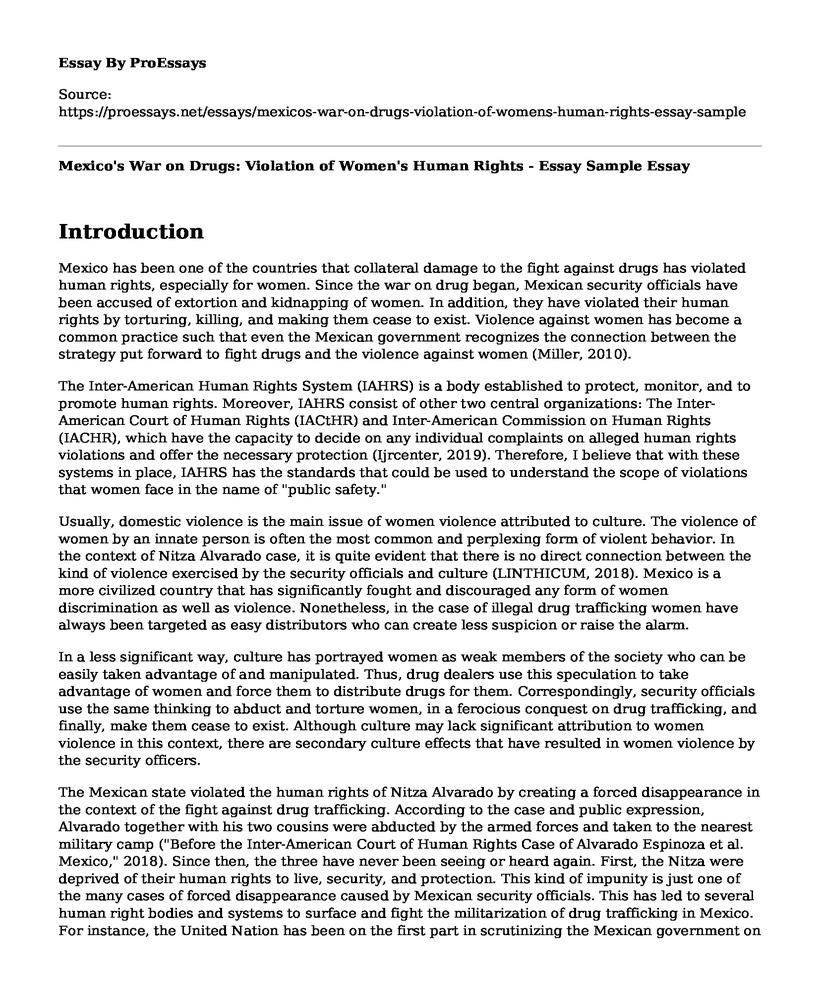Introduction
Mexico has been one of the countries that collateral damage to the fight against drugs has violated human rights, especially for women. Since the war on drug began, Mexican security officials have been accused of extortion and kidnapping of women. In addition, they have violated their human rights by torturing, killing, and making them cease to exist. Violence against women has become a common practice such that even the Mexican government recognizes the connection between the strategy put forward to fight drugs and the violence against women (Miller, 2010).
The Inter-American Human Rights System (IAHRS) is a body established to protect, monitor, and to promote human rights. Moreover, IAHRS consist of other two central organizations: The Inter-American Court of Human Rights (IACtHR) and Inter-American Commission on Human Rights (IACHR), which have the capacity to decide on any individual complaints on alleged human rights violations and offer the necessary protection (Ijrcenter, 2019). Therefore, I believe that with these systems in place, IAHRS has the standards that could be used to understand the scope of violations that women face in the name of "public safety."
Usually, domestic violence is the main issue of women violence attributed to culture. The violence of women by an innate person is often the most common and perplexing form of violent behavior. In the context of Nitza Alvarado case, it is quite evident that there is no direct connection between the kind of violence exercised by the security officials and culture (LINTHICUM, 2018). Mexico is a more civilized country that has significantly fought and discouraged any form of women discrimination as well as violence. Nonetheless, in the case of illegal drug trafficking women have always been targeted as easy distributors who can create less suspicion or raise the alarm.
In a less significant way, culture has portrayed women as weak members of the society who can be easily taken advantage of and manipulated. Thus, drug dealers use this speculation to take advantage of women and force them to distribute drugs for them. Correspondingly, security officials use the same thinking to abduct and torture women, in a ferocious conquest on drug trafficking, and finally, make them cease to exist. Although culture may lack significant attribution to women violence in this context, there are secondary culture effects that have resulted in women violence by the security officers.
The Mexican state violated the human rights of Nitza Alvarado by creating a forced disappearance in the context of the fight against drug trafficking. According to the case and public expression, Alvarado together with his two cousins were abducted by the armed forces and taken to the nearest military camp ("Before the Inter-American Court of Human Rights Case of Alvarado Espinoza et al. Mexico," 2018). Since then, the three have never been seeing or heard again. First, the Nitza were deprived of their human rights to live, security, and protection. This kind of impunity is just one of the many cases of forced disappearance caused by Mexican security officials. This has led to several human right bodies and systems to surface and fight the militarization of drug trafficking in Mexico. For instance, the United Nation has been on the first part in scrutinizing the Mexican government on the subject of disappearance of its people as well as the violation of human rights (OAS, 2009).
They are evaluating the depth of the impunity of violence against women and forced disappearance. Harsh reparations are required to reinstate and compensate the families affected. Thus, I feel that the family affected by impunity and violence of the security officers should be compensated in terms of monetary value. Secondly, the investigation into the whereabouts of some individuals that have ceased to exist should be thoroughly and effectively conducted to allow a detailed report that explains everything to the victims (Miller, 2010). Also, international bodies that fight for human rights should be allowed to intervene in the matter and allow victims to receive justice as well as answers about their loved ones. Finally, the Mexican government should strengthen and enhance the state bodies and commissions that monitor how security officers exercise their duties and uphold human rights.
References
Before the Inter-American Court of Human Rights Case of Alvarado Espinoza et al. Mexico. (2018). Human Rights Documents Online. doi:10.1163/2210-7975_hrd-9211-20180206
Ijrcenter. (2019). Inter-American Human Rights System. Retrieved September 30, 2019, from https://ijrcenter.org/regional/inter-american-system/
LINTHICUM, K. (2018, April 25). Soldiers took them in the night. Now Mexico's drug war strategy is on trial. Retrieved from https://www.latimes.com/world/mexico-americas/la-fg-mexico-disappeared-20180425-story.html
Miller, Z. J. (2010). Counterinsurgency and the Mexican Drug War. doi:10.21236/ada525024
OAS. (2009, August 1). IACHR Takes case involving Mexico to the Inter-American Court. Retrieved from https://www.oas.org/en/iachr/media_center/PReleases/2016/173.asp
Barcena, A., & Prado, A. (2015). Gender Equality Observatory of Latin America and the Caribbean. Santiago, Chile: United Nations Publications.
Cite this page
Mexico's War on Drugs: Violation of Women's Human Rights - Essay Sample. (2023, Feb 13). Retrieved from https://proessays.net/essays/mexicos-war-on-drugs-violation-of-womens-human-rights-essay-sample
If you are the original author of this essay and no longer wish to have it published on the ProEssays website, please click below to request its removal:
- Leadership Style in Nigerian Essay Example
- Essay Sample on Poverty in Brazil
- Speech Analysis Essay on Presidents Obama Speech at the Interfaith Prayer Service in Newtown
- Essay Sample on Codependency in Addiction: A Case Study of Coleen
- Essay Example on Exploitation of Poor: Illegal Trafficking of Human Organs
- Immigration to America in Late 1800s: Reasons & Effects - Essay Sample
- Report Sample: Relevance of the Declaration of Independence







